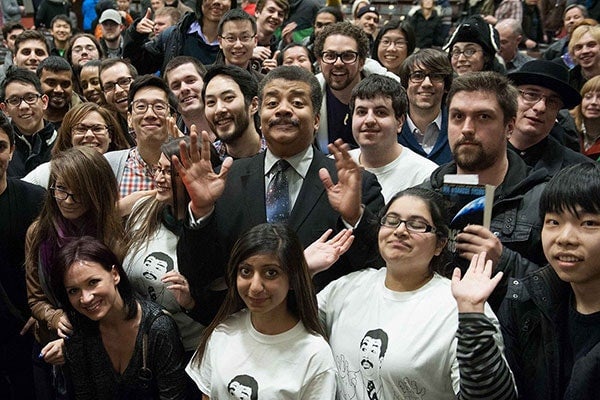
Science superstar Neil deGrasse Tyson thrills at sold-out Dunlap Prize Lecture
Published: March 28, 2014
“Why are you so popular?”
The question, from a seven-year-old in the upper balcony of a packed Convocation Hall, was directed at Neil deGrasse Tyson, not in the sense of “I don’t get why you’re so popular.” Rather, it was in the sense of “What is the secret to your huge success?”
Tyson—astrophysicist, author, StarTalk podcast host, director of the Hayden Planetarium, and star of the new TV series Cosmos—was at the University of Toronto to deliver the highly anticipated 2014 Dunlap Prize Lecture on March 21. (Three weeks earlier, the lecture sold out online in seconds.)
The talk was given in conjunction with Tyson receiving the inaugural Dunlap Prize from the Dunlap Institute for Astronomy & Astrophysics. The prize recognized his outstanding achievements which reflect the institute’s own public outreach goals.
Tyson’s answer to his young admirer’s question? “I pay attention to what it is about the Universe that excites people. And I share with them what excites me.”
But the better answer was the nearly three-hour lecture itself, during which Tyson turned Convocation Hall into a 'Starship of the Imagination,' and entertained, enlightened, challenged, inspired and connected with 1,500 adoring fans—including two generations of the Dunlap family.
The talk often felt like an engaging stream-of-consciousness mash-up of ideas that included evolution, the Periodic Table, 9/11, the Matrix, the Golden Age of Islam, politics, genetically-modified organisms, Tyson-as-meme, and Pluto. (Still bothered that Pluto’s no longer a planet? “Get over it,” he says.)
Throughout, Tyson paid tribute to Carl Sagan, as when he showed the audience a photograph taken by the Cassini spacecraft in orbit around Saturn. He pointed out the faint Earth in the image and, with the house lights dimmed, read a passage from Sagan’s 1994 book, Pale Blue Dot.
 From start to finish, it was a showcase for the connection Tyson has with his audience.
From start to finish, it was a showcase for the connection Tyson has with his audience.
By the end of the night, he’d had personal, one-on-one interactions with dozens of fans; he shared jokes, listened to people’s personal stories, accepted thanks for having inspired life choices, and answered questions:
Shouldn’t we be concerned about genetically-modified organisms (GMOs)? “We’ve been genetically engineering animals and plants to serve our needs since the dawn of agriculture. I don’t mind informed dissent. But people think they’re informed about GMOs and in fact they’re not.”
Should we educate politicians and improve their scientific literacy? “I don’t like talking to elected officials. As an educator, I look to the public. If I can compel the electorate to think scientifically, then they won’t tolerate elected officials who are scientifically illiterate. That’s how democracy is supposed to work.”
Do you think we might exist in a Matrix-like computer program? “Did a vastly more intelligent species make a zoo called Earth and we are their experiment? I’m intrigued by this. I will not rule it out. But one thing’s for sure: I’d wanna be Neo.”
How do you balance research and science communication? “There’s a trade-off. I’m here and I’m not in the lab. But I judge that there are things that I may be uniquely qualified to do and I would be irresponsible if I didn’t do them. The opportunity to host Cosmos when I have this history with Carl Sagan? How could I not do that?”
For all its humour and seeming spontaneity, the lecture was above all else a passionate argument for the importance and relevance of science and science education in society.
And it was science to which Tyson gave the final nod in his closing words: “Science and technology in the hands of enlightened people can transform the world. Let’s all try and do that together.”
The lecture was originally scheduled to end at 9:30 p.m., but Tyson, as the Bruce Springsteen of Science who won’t get off the stage, posed for a final selfie with fans crowding the stage at nearly midnight.
Not that many hours later, the world’s most famous “science bad ass” was on an early morning flight to Los Angeles for final on-camera work for Cosmos, his latest means of connecting with fans, sharing the Universe and transforming the world.
Chris Sasaki is a writer with the Dunlap Institute for Astronomy & Astrophysics at the University of Toronto.



